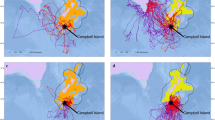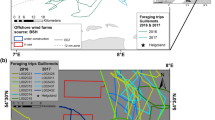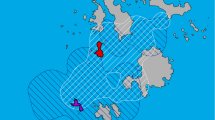Abstract
A step-wise reduction of fishery discards in the North Sea may have cascading effects on scavenging seabirds that rely on discards as a food resource. Understanding the interactions between seabirds and fisheries is thus crucial for seabird management and conservation. Using bird-borne GPS loggers, we investigate to what extent incubating lesser black-backed gulls Larus fuscus at Helgoland overlap on a spatio-temporal scale with fishing vessel positions obtained through the vessel monitoring system, as well as the distance around vessels at which birds adopt a non-random search behaviour that is indicative of the utilization of discards. We characterize foraging trips and discuss our findings in view of potential effects of the change of the European discard policy on lesser black-backed gulls. Individuals overlapped on a spatio-temporal scale with fishing vessels in one-third of the foraging trips (17 of 48 trips). Within <5 km of fishing vessels, birds exhibited lower flight speeds and higher path tortuosity values, indicating non-random search behaviour and thus the utilization of discards. To feed on discards, birds travelled greater total distances and spent more time away from the colony than birds feeding on non-discards, which is mainly due to the distant location of fishing grounds from the colony. Our results support previous studies showing the spatio-temporal overlap between birds and fishing vessels and behavioural switching from commuting to foraging. The inferred use of both discards and non-discards highlights the dual feeding strategy in this population, but a long-term reduction in discards may negatively affect the population on Helgoland, if sufficient alternative high-energetic food resources are not available within their foraging range.







Similar content being viewed by others
References
Bartumeus F, Giuggiolo L, Louzao M, Bretagnolle V, Oro D, Levin SA (2010) Fishery discards impact on seabird movement patterns at regional scales. Curr Biol 20:215–222
Bates D, Maechler M, Bolker B (2011) Package “lme4” for the R software: linear mixed-effects models using S4 classes. http://lme4.r-forge.r-project.org/
Bauer H-G, Bezzel E, Fiedler W (2005) Das Kompendium der Vögel Mitteleuropas. Band 1: Nonpasseriformes – Nichtsperlingsvögel. Aula-Verlag, Wiebelsheim
Beare D, Rijnsdorp AD, Blaesberg M, Damm U, Egekvist J, Fock HO, Kloppmann M, Röckmann C, Schroeder A, Schulze T, Tulp I, Ulrich C, van Hal R, van Kooten T, Verweij M (2013) Evaluating the effect of fisheries closures: lessons learnt from the Plaice Box. Neth J Sea Res 84:49–60
Bicknell AWJ, Oro D, Camphuysen KCJ, Votier SC (2013) Potential consequences of discard reform for seabird communities. J Appl Ecol 50:649–658
Bodey TW, Jessopp MJ, Votier SC, Gerritsen HD, Cleasby IR, Hamer KC, Patrick SC, Wakefield ED, Bearhop S (2014) Seabird movement reveals the ecological footprint of fishing vessels. Curr Biol 24:R514–R515
Camphuysen CJ (1995) Herring gull Larus argentatus and lesser black-backed gull L. fuscus feeding at fishing vessels in the breeding season: competitive scavenging versus efficient flying. Ardea 83:365–380
Camphuysen CJ, Shamoun-Baranes J, van Loon EE, Bouten W (2015) Sexually distinct foraging strategies in an omnivorous seabird. Mar Biol 162:1417–1428
Catchpole TL, Gray TS (2010) Reducing discards of fish at sea: a review of European pilot projects. J Environ Manag 91:717–723
Catchpole TL, Frid CLJ, Gray TS (2005) Discards in North Sea fisheries: causes, consequences and solutions. Mar Policy 29:421–430
Collet J, Patrick SC, Weimerskirch H (2015) Albatrosses redirect flight towards vessels at the limit of their visual range. Mar Ecol Prog Ser 526:199–205
Corman AC, Mendel B, Voigt CC, Garthe S (2016) Varying foraging patters in response to competition? A multicolony approach in a generalist seabird. Ecol Evol. doi:10.1002/ece3.1884
Development Core Team R (2012) R: a language and environment for statistical computing. R Foundation for Statistical Computing, Vienna
Dierschke J, Dierschke V, Hüppop K, Hüppop O, Jachmann KF (2011a) Die Vogelwelt der Insel Helgoland. OAG Helgoland, Helgoland
Dierschke J, Dierschke V, Schmaljohann H, Stühmer F (2011b) Ornithologischer Jahresbericht 2010 für Helgoland. Ornithologischer Jahresbericht Helgoland 21:1–84
Faraway JJ (2006) Extending the linear model with R: generalized linear, mixed effects and nonparametric regression models. Chapman and Hall, London
Fauchald P, Tveraa T (2003) Using first passage time in the analysis of area restricted search and habitat selection. Ecology 84:282–288
Fauchald P, Tveraa T (2006) Hierarchical patch dynamics and animal movement pattern. Oecologia 149:383–395
Fock HO (2008) Fisheries in the context of marine spatial planning: defining principal areas for fisheries in the German EEZ. Mar Policy 32:728–739
Fritz H, Said S, Weimerskirch H (2003) Scale-dependent hierarchical adjustments of movement patterns in a long-range foraging seabird. Proc R Soc Lond B 270:1143–1148
Furness RW, Ensor K, Hudson AV (1992) The use of fishery waste by gull populations around the British Isles. Ardea 80:105–113
Garthe S, Hüppop O (1994) Distribution of ship-following seabirds and their utilization of discards in the North Sea in summer. Mar Ecol Prog Ser 106:1–9
Garthe S, Scherp B (2003) Utilization of discards and offal from commercial fisheries by seabirds in the Baltic Sea. ICES J Mar Sci 60:980–989
Garthe S, Camphuysen CJ, Furness R (1996) Amounts of discards by commercial fisheries and their significance as food for seabirds in the North Sea. Mar Ecol Prog Ser 136:1–11
Garthe S, Flore B-O, Hälterlein B, Hüppop O, Kubetzki U, Südbeck P (2000) Die Brutbestandsentwicklung der Möwen (Laridae) an der deutschen Nordseeküste in der zweiten Hälfte des 20. Jahrhunderts. Vogelwelt 121:1–13
Granadeiro JP, Phillips RA, Brickle P, Catry P (2011) Albatrosses following fishing vessels: how badly hooked are they on an easy meal? PLoS ONE 6:e17467
Haney JC, Fristrup KM, Lee DS (1992) Geometry of visual recruitment by seabirds to ephemeral foraging flocks. Ornis Scand 23:49–62
Heath MR, Cook RM, Cameron AI, Morris DJ, Speirs DC (2014) Cascading ecological effects of eliminating fishery discards. Nat commun 5:3893. doi:10.1038/ncomms4893
Koffijberg K, Dijksen L, Hälterlein B, Laursen K, Potel P, Südbeck P (2006) Breeding Birds in the Wadden Sea in 2001—results of the total survey in 2001 and trends in numbers between 1991–2001. Wadden Sea ecosystem no. 22. Common Wadden Sea Secretariat, Trilateral Monitoring and Assessment Group, Joint Monitoring Group of Breeding Birds in the Wadden Sea, Wilhelmshaven
Koop B, Berndt RK (2014) Vogelwelt Schleswig-Holsteins, vol 7. Wachholtz Verlag, Neumünster, Zweiter Brutvogelatlas
Krüger T, Ludwig J, Pfützke S, Zang H (2014) Atlas der Brutvögel in Niedersachsen und Bremen 2005–2008. Naturschutz Landschaftspfl Niedersachsen 48:1–552
Navarro J, Louzao M, Arcos JM, Delgado A, Hobson KA, Oro D, Genovart M, Igual M, Forero MG (2009) Seasonal changes in the diet of a critically endangered seabird and the importance of trawling discards. Mar Biol 156:2571–2578
Olaso I, Sánchez F, Rodríguez-Cabello C, Velasco F (2002) The feeding behaviour of some demersal fish species in response to artificial discarding. Sci Mar 66:301–311
Oro D (1999) Trawler discards: a threat or a resource for opportunistic seabirds? In: Adams NJ, Slotow RH (eds) Proceedings of the 22nd International Ornithology Congress. Birdlife South Africa, Johannesburg, pp 717–730
Oro D, Jover L, Ruiz X (1996) Influence of trawling activity on the breeding ecology of a threatened seabird, Audouin’s gull Larus audouinii. Mar Ecol Prog Ser 139:19–29
Oro D, Ruiz X, Jover L, Pedrocchi V, González-Solís J (1997) Diet and adult time budgets of Audouin’s Gull Larus audouinii in response to changes in commercial fisheries. Ibis 139:631–637
Oro D, Cam E, Pradel R, Martínez-Abraín A (2004) Influence of food availability on demography and local population dynamics in a long-lived seabird. Proc R Soc Lond B 271:387–396
Patrick CS, Bearhop S, Grémillet D, Lescroël A, Grecian WJ, Bodey TW, Hamer KC, Wakefield E, Le Nuz M, Votier SC (2014) Individual differences in searching behaviour and spatial foraging consistency in a central place marine predator. Oikos 123:33–40
Patrick SC, Bearhop S, Bodey TW, Grecian WJ, Hamer KC, Lee J, Votier SC (2015) Individual seabirds show consistent foraging strategies in response to predictable fisheries discards. J Avian Biol 46:1–10
Ropert-Coudert Y, Wilson RP (2005) Trends and perspectives in animal-attached remote sensing. Front Ecol Environ 3:437–444
Schwemmer P, Garthe S (2005) At-sea distribution and behaviour of a surface-feeding seabird, the lesser black-backed gull (Larus fuscus), and is association with different prey. Mar Ecol Prog Ser 285:245–258
Schwemmer H, Schwemmer P, Ehrich S, Garthe S (2013) Lesser black-backed gulls (Larus fuscus) consuming swimming crabs: an important link in the food web of the southern North Sea. Estuar Coast Mar Sci 119:71–78
Stienen EWM, Brenninkmeijer A, Klaassen M (2008) Why do gull-billed terns Gelochelidon nilotica feed on fiddler crabs Uca tangeri in Guinea-Bissau? Ardea 96:243–250
Strann K, Vader W (1992) The nominate Lesser Black-backed Gull Larus fuscus fuscus, a gull with a tern-like feeding biology, and its recent decrease in northern Norway. Ardea 80:133–142
Tew Kai E, Benhamou S, van der Lingen CD, Coetzee JC, Pichegru L, Ryan PG, Grémillet D (2013) Are Cape gannets dependent upon fishery waste? A multi-scale analysis using seabird GPS-tracking, hydro-acoustic surveys of pelagic fish and vessel monitoring systems. J Appl Ecol 50:659–670
Thaxter CB, Ross-Smith VH, Bouten W, Clark NA, Conway GJ, Rehfisch MM, Burton NHK (2015) Seabird-wind farm interactions during the breeding season vary within and between years: a case study of lesser black-backed gull Larus fuscus in the UK. Biol Cons 186:347–358
Torres L, Thompson D, Bearhop S, Votier S, Taylor G, Sagar P, Robertson B (2011) White-capped albatrosses alter fine-scale foraging behavior patterns when associated with fishing vessels. Mar Ecol Prog Ser 428:289–301
Tyson C, Shamoun-Baranes J, Van Loon EE, Cmaphuysen CJ, Hintzen NT (2015) Individual specialization on fishery discards by lesser black-backed gulls (Larus fuscus). ICES J Mar Sci:doi. doi:10.1093/icesjms/fsv021
Ulleweit J, Stransky C, Panten K (2010) Discards and discarding practices in German fisheries in the North Sea and Northeast Atlantic during 2002–2008. J Appl Ichthyol Suppl 26(1):54–66. doi:10.1111/j.1439-0426.2010.01449.x
Votier SC, Bearhop S, Witt MJ, Inger R, Thompson D, Newton J (2010) Individual responses of seabirds to commercial fisheries revealed using GPS tracking, stable isotopes and vessel monitoring systems. J Appl Ecol 47:487–497
Votier SC, Bicknell A, Cox SL, Scales KL, Patrick SC (2013) A bird’s eye view of discard reforms: bird-borne cameras reveal seabird/fishery interactions. PLoS One 8:e57376
Wagner EL, Boersma PD (2011) Effects of fisheries on seabird community ecology. Rev Fish Sci 19:157–167
Walter U, Becker PH (1997) Occurrence and consumption of seabirds scavenging on shrimp trawler discards in the Wadden Sea. ICES J Mar Sci 54:684–694
Wilson RP, Pütz K, Peters G, Culik B, Scolaro JA, Charrassin J-B, Ropert-Coudert Y (1997) Long-term attachment of transmitting and recording devices to penguins and other seabirds. Wildl Soc Bull 25:101–106
Wood SN (2006) Generalized additive models: an introduction with R. Chapman and Hall, London
Acknowledgments
Fieldwork was financially supported by the Federal Ministry of Education and Research (03F0476B). We thank J. Dierschke, J. Beyer, P. Becker, N. Sonntag and associates of the Institute of Avian Research “Vogelwarte Helgoland” for their help with fieldwork. Special thanks to O. Hüppop for logistic support. G. Peters from Earth and Ocean Technologies provided technical support throughout the study.
Author information
Authors and Affiliations
Corresponding author
Additional information
Responsible Editor: V. H. Paiva.
Reviewed by S. Votier and an undisclosed expert.
Rights and permissions
About this article
Cite this article
Sommerfeld, J., Mendel, B., Fock, H.O. et al. Combining bird-borne tracking and vessel monitoring system data to assess discard use by a scavenging marine predator, the lesser black-backed gull Larus fuscus . Mar Biol 163, 116 (2016). https://doi.org/10.1007/s00227-016-2889-8
Received:
Accepted:
Published:
DOI: https://doi.org/10.1007/s00227-016-2889-8




